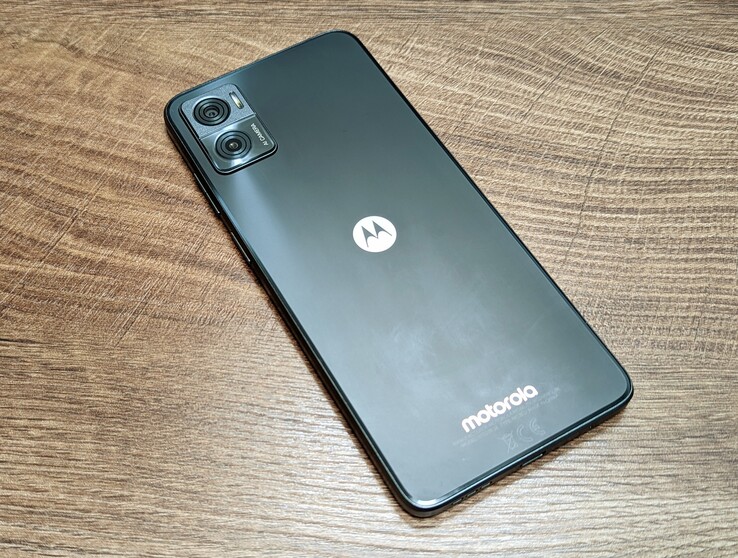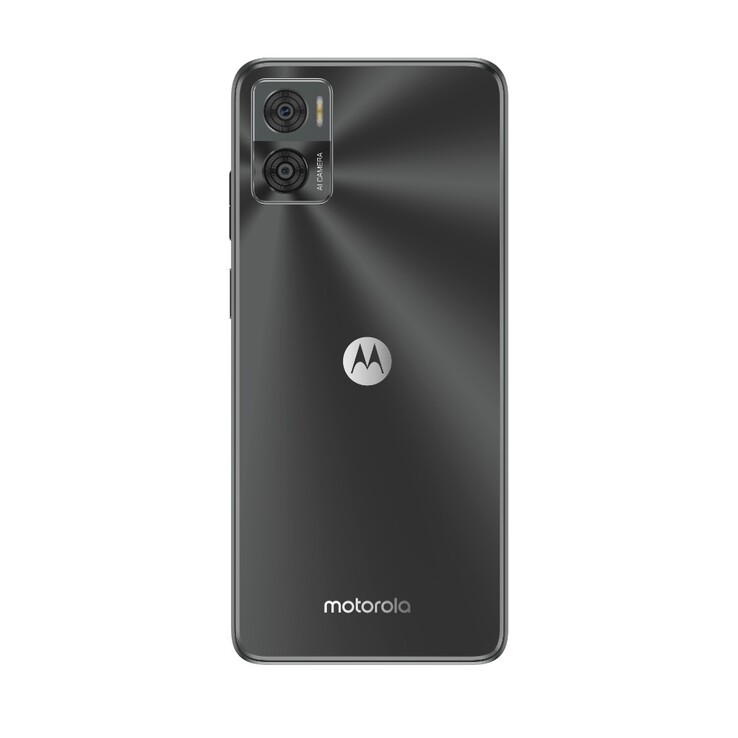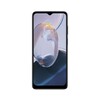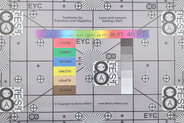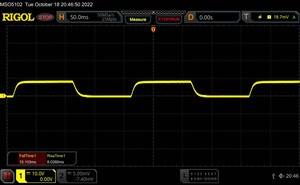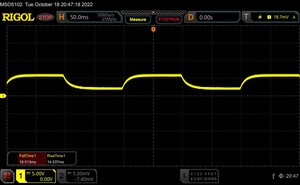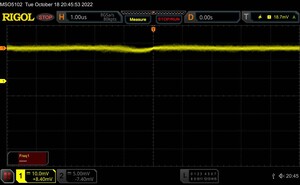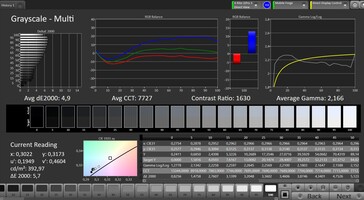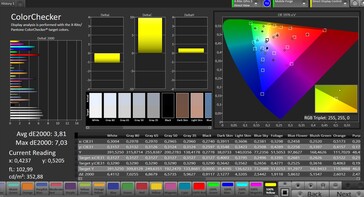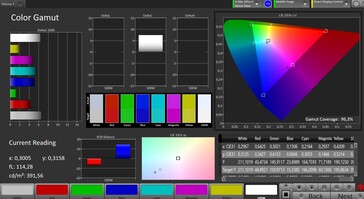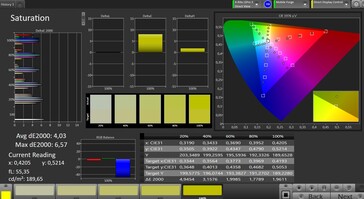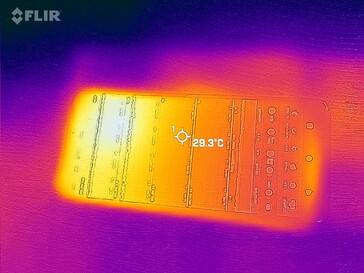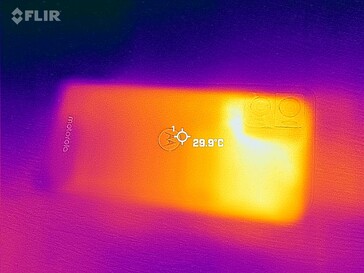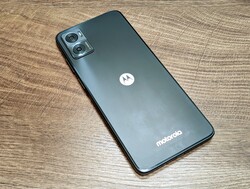Motorola Moto E22i smartphone review - Special phone for little money
Possible competitors in comparison
Bewertung | Datum | Modell | Gewicht | Laufwerk | Groesse | Aufloesung | Preis ab |
|---|---|---|---|---|---|---|---|
| 75.4 % v7 (old) | 10 / 2022 | Motorola Moto E22i Helio G37, PowerVR GE8320 | 169 g | 32 GB eMMC Flash | 6.50" | 1600x720 | |
| 75.1 % v7 (old) | 09 / 2022 | Motorola Moto E32s Helio G37, PowerVR GE8320 | 185 g | 32 GB eMMC Flash | 6.50" | 1600x720 | |
| 76.6 % v7 (old) | 07 / 2022 | Xiaomi Redmi 10C SD 680, Adreno 610 | 190 g | 64 GB UFS 2.2 Flash | 6.71" | 1650x720 | |
| 74.8 % v7 (old) | 07 / 2022 | Realme Narzo 50i Prime T7225 (T612), Mali-G52 MP1 | 182 g | 32 GB UFS 2.2 Flash | 6.50" | 1600x720 |
Case and features - Lightweight and rudimentary IP certification
If you do not look closely, it is hard to tell Motorola's inexpensive smartphones apart this year: The Moto E32, E32s and the Moto E22i, which we will test here, all rely on a matte back, a 6.5-inch screen, and very similar dimensions.
However, the Moto E22i is a bit lighter and minimally slimmer. It also has an edgier and, to our taste, more sophisticated-looking camera module. The phone, which costs just under 130 Euros (~$129) ex-works, is available in gray and white.
The phone can hardly be twisted and does not creak, but the front glass does not protect the screen from pressure very well. An IP52 certification does not say much about the water resistance, but at least the phone is quite well protected against dust.
There is currently only one storage variant of the low-priced phone in Europe: 32 GB of mass storage and 2 GB of RAM. Both are very tight even for a low-priced phone in 2022. NFC is also not available, so mobile payment services like Google Pay cannot be used.
At least the microSD card can be inserted into the phone in addition to 2 SIM cards. However, the read and write rates are a bit slower than in comparable smartphones in our test with the reference microSD card Angelbird V60.
| SD Card Reader - average JPG Copy Test (av. of 3 runs) | |
| Xiaomi Redmi 10C (Angelbird V60) | |
| Average of class Smartphone (5.72 - 58.9, n=69, last 2 years) | |
| Realme Narzo 50i Prime (Angelbird V60) | |
| Motorola Moto E32s (Angelbird V60) | |
| Motorola Moto E22i (Angelbird V60) | |
Cross Platform Disk Test (CPDT)
Communication, software and operation - Quick WLAN
We cannot complain about the Wi-Fi module: Fast Wi-Fi 5 is not yet standard for all manufacturers in this price range and the data rates in our test with the router Asus ROG Rapture AXE11000 are very stable and fast.
The Moto E22i is a 4G phone and has all the frequency bands required for Europe. However, you have to check whether mobile Internet access is possible in the destination country on trips further abroad - the selection of frequencies is not particularly large. The Motorola phone is not always convincing in our signal strength tests: It never completely loses contact with the network, but it has a much weaker reception than higher-quality phones.
Android 12 in the Go edition is installed on the smartphone, so the scarce storage space should not be clogged with unnecessary apps. Motorola installs quite pure Android on the smartphone, the security patches are from September 1, 2022 and are thus still reasonably up-to-date at the time of testing.
Since the inexpensive phone has a 90 Hz screen, you can scroll through menus and websites quite smoothly in some cases, but this is occasionally disturbed by jerks due to the SoC's very low performance. The fingerprint sensor is located on the casing's right and integrated into the standy button. The recognition is reliable and quite fast. Interestingly, Motorola does not allow unlocking via facial recognition.
| Networking | |
| iperf3 transmit AXE11000 | |
| Motorola Moto E22i | |
| Motorola Moto E32s | |
| Xiaomi Redmi 10C | |
| Realme Narzo 50i Prime | |
| iperf3 receive AXE11000 | |
| Motorola Moto E22i | |
| Motorola Moto E32s | |
| Xiaomi Redmi 10C | |
| Realme Narzo 50i Prime | |
Cameras - The single cam hardly inspires
The Moto E22i uses the same camera sensor as the Moto E32s the Hynix 1643 offers 16 megapixels and takes photos with decent dynamics in good lighting conditions, even though bright areas are a bit washed out. The test chart also looks overexposed in the lab. Details also always appear a bit blurry. In low light, the brightening is mediocre at best.
Videos can be recorded with 1080p and 30 fps. The autofocus usually works reliably, but the videos always look a bit blurry, just like the still pictures.
A 5-megapixel camera is found on the front. It barely manages any detail in dark areas and overall the photos look a bit grainy, so you should not enlarge them too much.
Image comparison
Choose a scene and navigate within the first image. One click changes the position on touchscreens. One click on the zoomed-in image opens the original in a new window. The first image shows the scaled photograph of the test device.
Main camera FlowerMain camera EnvironmentMain camera Low Light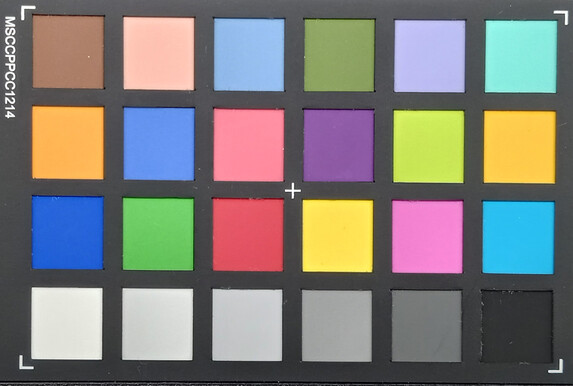
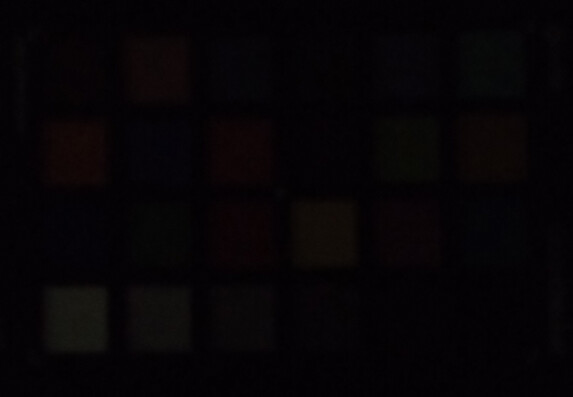
Display - few pixels, but 90 Hz
The display resolves with a class-standard but still low 1,600 x 720 pixels. It supports 60 or 90 Hz frame rates and manages without PWM flickering even at low brightness.
The screen's maximum brightness is relatively low, but the low black value allows for somewhat stronger contrasts and colors. The accuracy of the color reproduction is also better than in comparable smartphones, but we can still detect a slight blue cast in the grayscale.
| |||||||||||||||||||||||||
Brightness Distribution: 86 %
Center on Battery: 390 cd/m²
Contrast: 1625:1 (Black: 0.24 cd/m²)
ΔE ColorChecker Calman: 3.81 | ∀{0.5-29.43 Ø4.78}
ΔE Greyscale Calman: 4.9 | ∀{0.09-98 Ø5}
96.3% sRGB (Calman 2D)
Gamma: 2.166
CCT: 7727 K
| Motorola Moto E22i IPS, 1600x720, 6.5" | Motorola Moto E32s IPS, 1600x720, 6.5" | Xiaomi Redmi 10C IPS, 1650x720, 6.7" | Realme Narzo 50i Prime IPS, 1600x720, 6.5" | |
|---|---|---|---|---|
| Response Times | -8% | -7% | -3% | |
| Response Time Grey 50% / Grey 80% * (ms) | 34 ? | 30 ? 12% | 33 ? 3% | 34 ? -0% |
| Response Time Black / White * (ms) | 18 ? | 23 ? -28% | 21 ? -17% | 19 ? -6% |
| PWM Frequency (Hz) | ||||
| Screen | -31% | 16% | -25% | |
| Brightness middle (cd/m²) | 390 | 346 -11% | 511 31% | 365 -6% |
| Brightness (cd/m²) | 355 | 330 -7% | 478 35% | 354 0% |
| Brightness Distribution (%) | 86 | 90 5% | 84 -2% | 83 -3% |
| Black Level * (cd/m²) | 0.24 | 0.47 -96% | 0.42 -75% | 0.45 -88% |
| Contrast (:1) | 1625 | 736 -55% | 1217 -25% | 811 -50% |
| Colorchecker dE 2000 * | 3.81 | 5.4 -42% | 1.51 60% | 4.58 -20% |
| Colorchecker dE 2000 max. * | 7.03 | 9 -28% | 2.53 64% | 8.81 -25% |
| Greyscale dE 2000 * | 4.9 | 5.5 -12% | 2.9 41% | 5.2 -6% |
| Gamma | 2.166 102% | 2.874 77% | 2.266 97% | 2.28 96% |
| CCT | 7727 84% | 5971 109% | 6443 101% | 7929 82% |
| Total Average (Program / Settings) | -20% /
-26% | 5% /
12% | -14% /
-20% |
* ... smaller is better
Display Response Times
| ↔ Response Time Black to White | ||
|---|---|---|
| 18 ms ... rise ↗ and fall ↘ combined | ↗ 10 ms rise | |
| ↘ 8 ms fall | ||
| The screen shows good response rates in our tests, but may be too slow for competitive gamers. In comparison, all tested devices range from 0.1 (minimum) to 240 (maximum) ms. » 39 % of all devices are better. This means that the measured response time is better than the average of all tested devices (20.2 ms). | ||
| ↔ Response Time 50% Grey to 80% Grey | ||
| 34 ms ... rise ↗ and fall ↘ combined | ↗ 19 ms rise | |
| ↘ 15 ms fall | ||
| The screen shows slow response rates in our tests and will be unsatisfactory for gamers. In comparison, all tested devices range from 0.165 (minimum) to 636 (maximum) ms. » 45 % of all devices are better. This means that the measured response time is similar to the average of all tested devices (31.6 ms). | ||
Screen Flickering / PWM (Pulse-Width Modulation)
| Screen flickering / PWM not detected | |||
In comparison: 53 % of all tested devices do not use PWM to dim the display. If PWM was detected, an average of 8108 (minimum: 5 - maximum: 343500) Hz was measured. | |||
Performance, emissions and battery life - The Helio G37 as bottleneck
The MediaTek Helio G37 has already been installed by Motorola in several smartphones, for example in the Moto G22 or in the Moto E32s. So far, the SoC could not really impress even in inexpensive smartphones; the performance is simply too low. This is also a problem in the Moto E22i, as the benchmarks show the Redmi 10C or realme Narzo 50i Prime are also very inexpensive, but have much more power.
Even on its own, the smartphone is very slow and has almost no performance reserves when running more demanding tasks. Loading times are relatively long, also thanks to the slow memory, and operation often falters. At least the smartphone barely warms up under prolonged load.
Motorola might have scored a coup with the speakers, since stereo speakers are hardly ever found in a phone under 150 Euros (~$148). And indeed, the Moto E22i does not sound exceptionally loud, but overall much more pleasant than comparable phones. Nevertheless, the sound is only really good when headphones or speakers are connected via a 3.5 mm jack or Bluetooth. The codec diversity for wireless transmission is acceptable, for example, aptX HD is available.
The battery is quite small: Motorola only provides 4,020 mAh, which is only enough for a runtime of 12:33 hours in our WLAN test. That is considerably less than comparable phones. Since the smartphone charges with a maximum of 10 watts, a full charge still takes over 2 hours.
| 3DMark | |
| 2560x1440 Sling Shot OpenGL ES 3.0 Unlimited | |
| Average of class Smartphone (953 - 22613, n=18, last 2 years) | |
| Xiaomi Redmi 10C | |
| Motorola Moto E32s | |
| Average Mediatek Helio G37 (895 - 921, n=3) | |
| Motorola Moto E22i | |
| 2560x1440 Sling Shot OpenGL ES 3.0 Unlimited Graphics | |
| Average of class Smartphone (879 - 45492, n=18, last 2 years) | |
| Xiaomi Redmi 10C | |
| Motorola Moto E32s | |
| Average Mediatek Helio G37 (838 - 853, n=3) | |
| Motorola Moto E22i | |
| 2560x1440 Sling Shot OpenGL ES 3.0 Unlimited Physics | |
| Average of class Smartphone (1352 - 8203, n=18, last 2 years) | |
| Xiaomi Redmi 10C | |
| Motorola Moto E32s | |
| Average Mediatek Helio G37 (1173 - 1292, n=3) | |
| Motorola Moto E22i | |
| GFXBench | |
| on screen Aztec Ruins Normal Tier Onscreen | |
| Average of class Smartphone (6.2 - 166, n=211, last 2 years) | |
| Xiaomi Redmi 10C | |
| Realme Narzo 50i Prime | |
| Motorola Moto E32s | |
| Motorola Moto E22i | |
| Average Mediatek Helio G37 (7 - 7.9, n=4) | |
| 1920x1080 Aztec Ruins Normal Tier Offscreen | |
| Average of class Smartphone (3.4 - 367, n=211, last 2 years) | |
| Xiaomi Redmi 10C | |
| Realme Narzo 50i Prime | |
| Motorola Moto E32s | |
| Motorola Moto E22i | |
| Average Mediatek Helio G37 (4 - 4.2, n=4) | |
| on screen Aztec Ruins High Tier Onscreen | |
| Average of class Smartphone (0.85 - 144, n=212, last 2 years) | |
| Xiaomi Redmi 10C | |
| Realme Narzo 50i Prime | |
| Motorola Moto E32s | |
| Average Mediatek Helio G37 (4.9 - 5, n=4) | |
| Motorola Moto E22i | |
| 2560x1440 Aztec Ruins High Tier Offscreen | |
| Average of class Smartphone (1.2 - 129, n=211, last 2 years) | |
| Xiaomi Redmi 10C | |
| Realme Narzo 50i Prime | |
| Motorola Moto E32s | |
| Motorola Moto E22i | |
| Average Mediatek Helio G37 (1.5 - 1.5, n=4) | |
| Motorola Moto E22i | Motorola Moto E32s | Xiaomi Redmi 10C | Realme Narzo 50i Prime | Average 32 GB eMMC Flash | Average of class Smartphone | |
|---|---|---|---|---|---|---|
| AndroBench 3-5 | -5% | 227% | 209% | -31% | 692% | |
| Sequential Read 256KB (MB/s) | 263.1 | 248.6 -6% | 927.7 253% | 658.2 150% | 242 ? -8% | 2226 ? 746% |
| Sequential Write 256KB (MB/s) | 189 | 184.3 -2% | 510.2 170% | 445.6 136% | 100.5 ? -47% | 1848 ? 878% |
| Random Read 4KB (MB/s) | 53.6 | 49.1 -8% | 120.2 124% | 161.8 202% | 43.1 ? -20% | 295 ? 450% |
| Random Write 4KB (MB/s) | 42.3 | 40 -5% | 195.2 361% | 189.8 349% | 22.3 ? -47% | 335 ? 692% |
Temperature
(+) The maximum temperature on the upper side is 38.8 °C / 102 F, compared to the average of 35.2 °C / 95 F, ranging from 21.9 to 247 °C for the class Smartphone.
(±) The bottom heats up to a maximum of 40.3 °C / 105 F, compared to the average of 34 °C / 93 F
(+) In idle usage, the average temperature for the upper side is 22 °C / 72 F, compared to the device average of 32.9 °C / 91 F.
Speaker
Motorola Moto E22i audio analysis
(±) | speaker loudness is average but good (79.2 dB)
Bass 100 - 315 Hz
(-) | nearly no bass - on average 30.5% lower than median
(±) | linearity of bass is average (9% delta to prev. frequency)
Mids 400 - 2000 Hz
(+) | balanced mids - only 4.9% away from median
(±) | linearity of mids is average (7% delta to prev. frequency)
Highs 2 - 16 kHz
(+) | balanced highs - only 1.7% away from median
(+) | highs are linear (1.8% delta to prev. frequency)
Overall 100 - 16.000 Hz
(±) | linearity of overall sound is average (21.4% difference to median)
Compared to same class
» 41% of all tested devices in this class were better, 8% similar, 51% worse
» The best had a delta of 11%, average was 35%, worst was 134%
Compared to all devices tested
» 59% of all tested devices were better, 7% similar, 34% worse
» The best had a delta of 4%, average was 24%, worst was 134%
Motorola Moto E32s audio analysis
(±) | speaker loudness is average but good (80.6 dB)
Bass 100 - 315 Hz
(-) | nearly no bass - on average 29.2% lower than median
(±) | linearity of bass is average (13.1% delta to prev. frequency)
Mids 400 - 2000 Hz
(±) | higher mids - on average 5.9% higher than median
(±) | linearity of mids is average (7.1% delta to prev. frequency)
Highs 2 - 16 kHz
(+) | balanced highs - only 3.3% away from median
(+) | highs are linear (4% delta to prev. frequency)
Overall 100 - 16.000 Hz
(±) | linearity of overall sound is average (24.7% difference to median)
Compared to same class
» 59% of all tested devices in this class were better, 7% similar, 34% worse
» The best had a delta of 11%, average was 35%, worst was 134%
Compared to all devices tested
» 75% of all tested devices were better, 5% similar, 20% worse
» The best had a delta of 4%, average was 24%, worst was 134%
Battery life
| Battery Runtime - WiFi Websurfing | |
| Average of class Smartphone (12.1 - 54.1, n=212, last 2 years) | |
| Motorola Moto E32s | |
| Realme Narzo 50i Prime | |
| Xiaomi Redmi 10C | |
| Motorola Moto E22i | |
Pros
Cons
Verdict - It all depends on the requirements
Of course, the Motorola Moto E22i is and remains a very inexpensive phone and you have to lower your expectations. However, it does have its advantages: The phone is light and a bit more compact than comparable phones, and it has a nice design. Stereo speakers that sound quite acceptable are rarely seen in this class, as is a 90 Hz display. However, the latter can only rarely show its advantages because the general system performance is too slow.
Thus, we can only repeat our lament about the SoC, which is also used in some other inexpensive Motorola phones: The Helio G37 does not offer enough performance to run completely smoothly, even for the most basic navigation in the system and the Moto E22i has to deal with the very tight working memory.
So, it depends on your priorities and budget: The slow processor can quickly spoil the fun of the phone, but if you are looking for a really cheap phone with stereo speakers and a fast screen, you can risk a look. However, the small battery and the very slow charging technology are also annoying.
The Motorola Moto E22i brings up the rear in terms of performance, but wants to make up for that with stereo speakers and lightweight construction.
The first alternative comes from their own company: If you do not mind the additional weight, you can get the Moto E32 you get much more power and a faster charging technology. The Xiaomi Redmi 10C goes one better with more power and battery performance, but only has a 60 Hz display.
Price and availability
The phone is available directly from the manufacturer for just under 130 Euros (~$129). If you want to save a few Euros, you can find the inexpensive Motorola phone a bit cheaper on the Internet at the time of testing.
Motorola Moto E22i
- 10/24/2022 v7 (old)
Florian Schmitt




